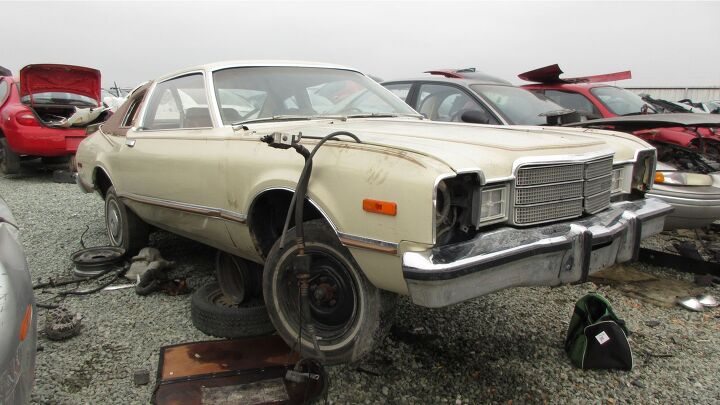#PlymouthVolare
Rare Rides: The Especially Forgotten 1978 Dodge Aspen Kit Car
The standard Dodge Aspen and Plymouth Volare are primarily remembered (and not seen) because they rusted as soon as the dew settled on them on a spring morning. While that makes standard examples sort of rare today, there’s a very special model which was very rare from the beginning.
It’s the 1978 Dodge Aspen Kit Car, and that’s its real name.
Junkyard Find: 1976 Plymouth Volare Coupe
The A-Body Plymouth Valiant (and its Dodge sibling, the Dart), stayed in American production from the 1960 model year all the way through 1976. Legendary for its sturdiness, the Valiant was sure to be a tough act to follow. The Plymouth Volarés and Dodge Aspens appeared in 1976, never gained the affection given to their predecessors, and were facelifted and renamed the Gran Fury and Diplomat in 1981. Here’s a luxed-up first-year Volaré I spotted in a Northern California self-service yard.
Junkyard Find: 1976 Plymouth Volare Sedan
The Dodge Aspen/Plymouth Volaré won the Motor Trend Car of the Year award for 1976, and they spent a good decade among the most commonplace vehicles on American roads. Then just about all of them disappeared, no doubt as they depreciated well below scrap value in about ten years. However, the occasional odds-beating survivor shows up in wrecking yards now and then; we’ve seen this ’76 Aspen sedan, this brown-on-beige ’77 Volaré coupe and this ’77 Volaré Premier wagon, and now today’s ’76 Volaré sedan. This one shows evidence of having sat for the last decade or so, but still managed to rack up many more miles than most of its Civic and Corolla contemporaries.
Junkyard Find: 1977 Plymouth Volare Premier Station Wagon
The successor to the incredibly successful Dodge Dart/Plymouth Valiant was the Dodge Aspen/Plymouth Volaré. These simple rear-wheel-drive cars sold fairly well, but for every Aspen or Volaré I see in high-turnover wrecking yards today, I find ten Darts and Valiants. Part of that reason is a short production run, part is (arguably) lower build quality, but I’m guessing the main reason is that Americans just didn’t love the F-body Chryslers the way they did the A-body. When a Valiant got sick (which wasn’t often), it got fixed; when a Volaré came down with some expensive problem, it got crushed. Now these things are almost nonexistent, but here’s a very rare Volaré Premier wagon I spotted in a California yard a few months back.
Junkyard Find: 1977 Plymouth Volare
The Volaré and its Dodge sibling, the Aspen, were perfectly competent cars for their time, (anectodally) more reliable than the Chevy Nova and Ford Maverick (and, later, the Fairmont) competition and, if you looked at them from the right angle, better looking. Still, they were never quite as beloved as the Dart/Valiant A-bodies that they replaced, and they have not aged well. In fact, most of them got crushed during the 1990s, so it’s not often that I see examples like this one in self-service wrecking yards.
Car of the Year Revisionism, 1976 Edition: If Not the Volare/Aspen, What?
We went all 20/20 hindsight on the 1970 Motor Trend COTY choice yesterday, and today we’ll be jumping right into the depths of the Malaise Era for the MT gurus’ 1976 choice: the Dodge Aspen/ Plymouth Volaré





















Recent Comments